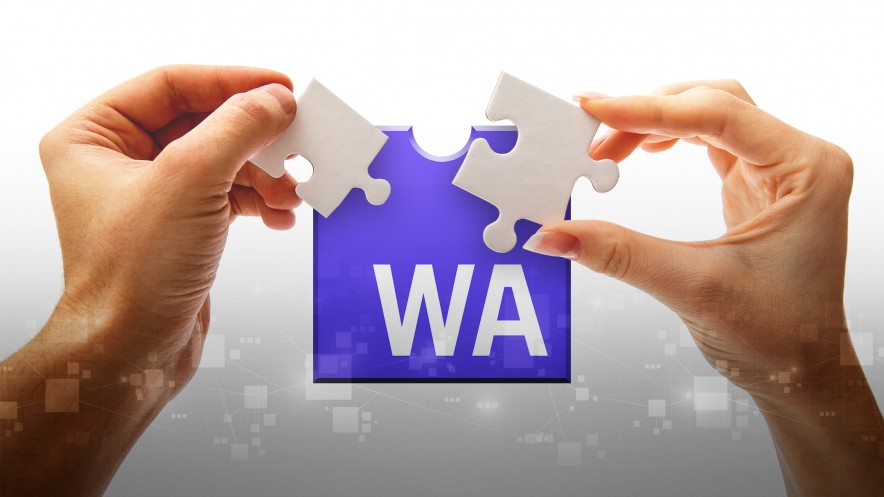Examining Ethereum 2.0: This Is Not Your Granny’s Blockchain
Aug 14, 2019, 7:14pm
Ethereum 2.0 is about to turn everyone's favorite #2 crypto into the world supercomputer it was always meant to be: fast, efficient, and slick.
The Ethereum project has proven to be one of the most exciting developments in the world of blockchain, and it is finally getting ready to reinvent itself to become all it was meant to be. Yes, Bitcoin’s chain was first, and it has shaped the perception and culture of the crypto-world ahead of it, with dizzying highs and massive hype-pumped-media-fueled-speculation-extravaganzas, but, behind Bitcoin, Ethereum has been busy shaping the very essence of blockchain technology, quietly toiling in the background, developing this “whole blockchain thing” into something much more than just an interesting currency experiment.
If you don’t know what Ethereum is, our Ethereum Wiki is a good place to start, as is the absolutely outstanding beginner’s page from the official Ethereum.org website. If you want the short, all-too-basic explanation, I’ll give it to you:
Ethereum isn’t simply a decentralized form of money, it’s a decentralized network. We’re not talking just any network either, we’re talking about a global network, so sophisticated and large that it will someday be capable of doing everything the internet can do, but in a decentralized manner. Currency, banking, contractual agreements, adorable apps where you can collect confusingly valuable cats, you name it, Ethereum will do it. Or, at least, that’s what the developers working on the project would like to achieve.
The thing is, Ethereum’s ambitions and potential purposes extend far beyond the capabilities of the network thus far, and the Ethereum network’s lofty plan to become the “World Computer” of tomorrow has been fraught with obstacles since it started to gain momentum, namely stemming from two major problems: scalability and performance. Now, after 4 years of development, trial and error, and a healthy dose of cryptocurrency market insanity, Ethereum looks like it has finally put together the roadmap it needs to solve the issues of scalability and performance with its next update: Ethereum 2.0
What is Ethereum 2.0?
Ethereum 2.0 is a major protocol upgrade for Ethereum, for the network and the community. It is a pretty radical approach in that we have the existing Ethereum 1.0 chain, and we are architecting an entirely new and scalable proof-of-stake system to live in parallel with the existing chain.
/ Danny Ryan, Ethereum Foundation Researcher, EDCON 2019
Ethereum 2.0 is a new iteration of the Ethereum blockchain that will use a proof-of-stake (PoS) consensus mechanism rather than proof-of-work (PoW). This new chain will be called the “Beacon Chain”, and will run parallel to the existing Ethereum 1.0 chain. This will allow developers to work on the new chain without having to risk compromising the functioning Ethereum 1.0 mainnet as it stands right now.
The move to PoS has been a long-anticipated upgrade to the Ethereum blockchain, and for good reason. Ethereum currently runs on a PoW blockchain, similar to Bitcoin, and it has some serious downfalls. With PoW, miners use expensive hardware and relatively large amounts of electricity to compete with each other while trying to solve a mathematically difficult cryptographic problem. As more miners join the network, the problem gets more difficult, requiring more equipment and more electricity – a feedback loop that makes this method of consensus inefficient and prohibitively expensive for most users.
With PoS, miners are replaced with validators. These “validators” are a set of nodes that “stake” a predetermined amount of ETH on the network in order to earn the right to vote in the consensus process. Validators will propose new blocks to add to the chain and validate new transactions, and because they are “staked” in the network, they are given a certain amount of trust from the network in return. Validators will also be held accountable for their behavior, facing penalties for bad behavior, like voting on invalid transactions. While not perfect, this type of consensus mechanism will give Ethereum the ability to significantly downsize the amount of time and energy it takes to perpetuate the network’s consensus mechanism, and if Ethereum 2.0 can get PoS mostly right, it will prove as a good case study into just how well PoS can function in the “real world”.
At first, the Beacon Chain will not support smart contracts or accounts and will serve the sole purpose of maintaining a set of validators for the chain. These validators will only need to stake 32 ETH in order to participate in the consensus voting system, making the barrier to entry relatively low (about $6500), allowing many individuals to become validators if they so choose. This will help Ethereum become more decentralized over time. At least, that is the plan.
PoS is important, we need to stop wasting electricity right now, so it’s important, but without scaling, the only use [for the network] is token speculation. So I really believe we need scalability so that people can use Blockchain applications.
/ Vitalik Buterin, Founder of Ethereum
PoS isn’t the be-all-end-all solution that Ethereum is looking for, but merely the first piece in the puzzle. The really exciting and groundbreaking part of Ethereum 2.0 comes in the form of “Sharding”, a proposed solution that looks to partition Ethereum’s total database into many “shards”, each representing their own independent piece of state and transaction history.
At present, the Ethereum network needs every node on the network to validate every transaction on the network. This means that the entire Ethereum blockchain is only as fast as its individual nodes, causing the network to be easily bogged down when experiencing heavy transaction volume. With Sharding, each shard is responsible for only a portion of the total transactions, meaning that transactions can be processed in their “local” shard much quicker than the present “global chain” method, as validating is reliant on a much smaller subset of nodes. Eventually, Ethereum 2.0 will allow shards to communicate with each other via “cross-links” and “receipts”, but this development is still a ways off, and will be contingent on how well sharding fairs in real-world testing on a more basic level first. For now, the first implementation of sharding will happen on the Beacon Chain, where the PoS validators will be randomly assigned to process a particular shard’s transactions. This first iteration will allow only 100 shards, and no shards will process accounts, assets or smart contracts.
Imagine that Ethereum has been split into thousands of islands. Each island can do its own thing. Each of the islands has its own unique features and everyone belonging on that island, i.e., the accounts, can interact with each other and they can freely indulge in all its features. If they want to contact with other islands, they will have to use some sort of protocol.
/ Vitalik Buterin, Founder of Ethereum
Sharding and PoS will vastly improve the functionality of the Ethereum blockchain as we know it today, and we will likely see the beginnings of these upgrades start to take their first forms sometime before the end of 2020, but Ethereum 2.0 proposes a radical change to the very essence of Ethereum’s blockchain far beyond PoS and Sharding, one that is still largely in the research phase: eWASM.
Ethereum is at the point where it’s transitioning from a clunky homebrew custom build job that we’ve been riding around our farm to a real racecar that we can take out on the highway and open up.
/ Lane Rettig, Ethereum Core Developer
The current Ethereum blockchain is powered by the “Ethereum Virtual Machine”, or EVM. It is the engine that executes every smart contract, token, dApp, and DAO on the network today, and it is a testament to the genius that is Ethereum. Written and developed by the core devs who brought Ethereum to life, EVM is a virtual computer unlike the world has ever seen, and that is exactly why it needs to be replaced.
EVM was never meant to be used as a practical tool for developers from outside the Ethereum universe. EVM is said to be “optimized for theoretical purity, rather than practical use”. Without getting too technical, EVM has three major downfalls: it restricts developers to using Ethereum’s native programming language, Solidity, it needs to precompile certain operations within its system, and it relies on converting all computations into 256-bit strings before executing them. The symptoms of these problems can be somewhat mitigated with Sharding and PoS, but a total overhaul of the EVM is the only true solution.
The eWASM solution looks to solve these problems and then some, by swapping out Ethereum’s EVM engine for a modified version of the WASM (or WebAssembly code), called eWASM. WASM was initially created by the World Wide Consortium (W3C), which is the group of developers responsible for maintaining the World Wide Web, otherwise known as the “Internet”, you may have heard of it. The fact is, the W3C consists of many highly paid, extremely prolific engineers, and they have built a construction set that is unparalleled in the world of network development, so the adaptation of WASM into the world of Ethereum and blockchain would give blockchain developers a world-class tool-set far more useful than the clunky EVM.
eWASM is still in the research phase, but it will be the key to allowing Ethereum 2.0’s Sharding and PoS Beacon Chain to fully function with smart contracts, accounts, states, and dApps in a fashion comparable to the current version of Ethereum. eWASM will support multiple programming languages, not just Solidity, and its code will be extremely efficient with regard to hardware optimization, allowing Ethereum 2.0 to run as efficiently as possible in every scenario. eWASM will also do away with the clunky “precompiles” used by the EVM by allowing developers to write operations as smart contracts that can then be executed, an advantage that will vastly improve Ethereum’s development process.
Conclusion
With Sharding and PoS coming online before the end of 2020, Ethereum 2.0 will finally allow the project to grow into its potential and begin to overcome the obstacles it has faced since the blockchain explosion of 2017. eWASM is more than just a pipe dream at this point, but there is no solid data or construct that can show us exactly how eWASM will affect the project upon implementation. Ethereum 2.0 has a long road ahead of it, and we’d all be kidding ourselves if we thought the road would be without new obstacles of its own, but one thing is for certain:
There Ethereum community is thriving, and blockchain is more exciting than ever. While many new blockchain projects are being developed, Ethereum is by far the #1 network when it comes to development. For those who want to catch a glimpse into what the future of blockchain might look like, Ethereum 2.0 is the best project to watch.





